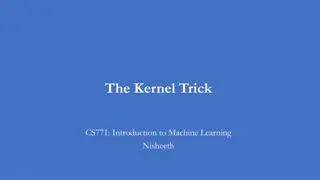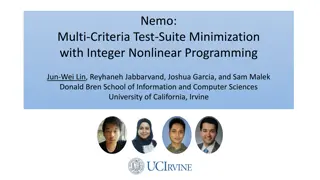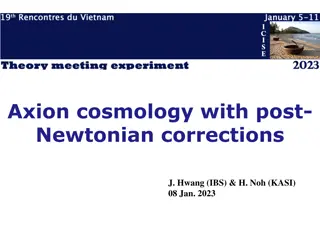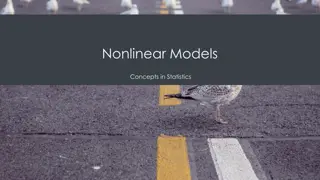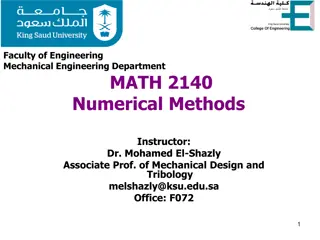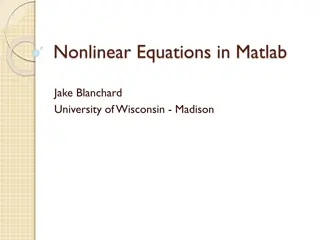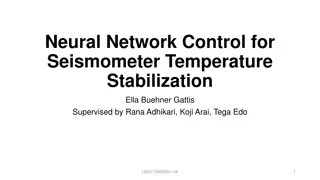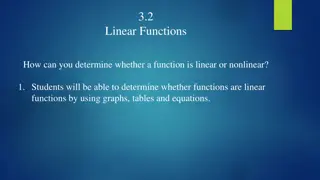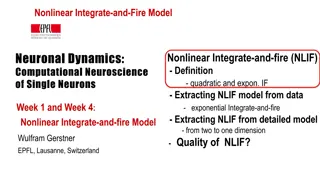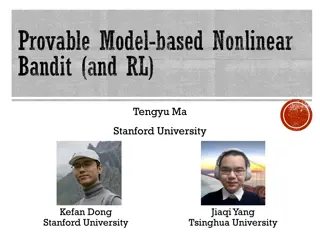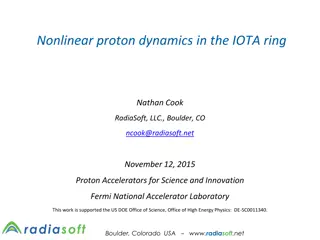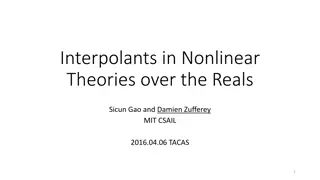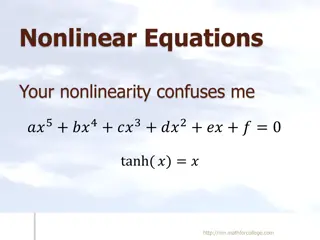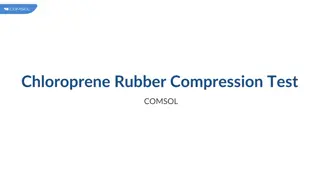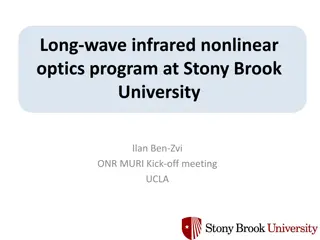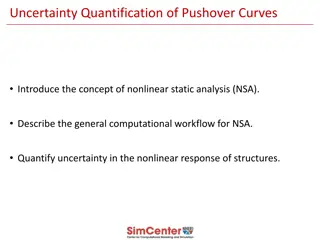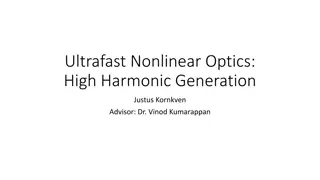Autoresonance in Nonlinear Systems: An Overview
Autoresonance (AR) is a phenomenon where a weakly driven nonlinear system stays in resonance with its drive as frequencies vary in time. Initially observed in particle acceleration, AR has found applications in various fields. However, the complexity of AR in multi-dimensional systems differs from single oscillators. This work explores the behavior of systems with harmonic and nonlinear actuator forcing, demonstrating varied responses. The study highlights how seemingly similar systems can exhibit different dynamical behavior due to resonance properties.
Download Presentation

Please find below an Image/Link to download the presentation.
The content on the website is provided AS IS for your information and personal use only. It may not be sold, licensed, or shared on other websites without obtaining consent from the author.If you encounter any issues during the download, it is possible that the publisher has removed the file from their server.
You are allowed to download the files provided on this website for personal or commercial use, subject to the condition that they are used lawfully. All files are the property of their respective owners.
The content on the website is provided AS IS for your information and personal use only. It may not be sold, licensed, or shared on other websites without obtaining consent from the author.
E N D
Presentation Transcript
INTRODUCTION Autoresonance (AR) is the tendency of a weakly driven nonlinear system to stay in resonance with its drive when the forcing and/or system frequencies slowly vary in time. Example: the Duffing equation 2 d u + + = 3 8 2 cos ( ), u au F t 2 dt d = + = 1 2 ( ), ; t 1 1 dt 0 < << 1; ( 1) =s+ b 1, s > 0, b > 0, > 0. The system is assumed to be initially at rest; u= 0, v=du/dt= 0 at t= 0. In the linear system, the change of the driving frequency entails the exit from resonance. In the NL system, the slow change of the driving frequency entails a gradual increase of the oscillations amplitude along with an increase of the instant natural frequency. If these processes are synchronized to some extent, the resonance growth of the amplitude is preserved.
AR was first employed in the problem of particle acceleration (V.I. Veksler, 1945, E.M. McMillan, 1946) and reported as nonlinear phase-locking between the system and the driving signal. Many new applications of AR in atomic and molecular physics, fluid dynamics, nonlinear waves, plasmas, superconductivity, planetary dynamics have appeared ever since. The analysis was first concentrated on the study of AR in the basic nonlinear oscillator but then it was extended to two- or three- dimensional systems. In most of these studies, AR was considered as an effective method of excitation and control of high-energy oscillations in the entire system.
In this work we demonstrate that this conclusion cannot be applied universally because AR in the multi-dimensional system is a much more complicated phenomenon than AR in a single oscillator, and the behavior of each element in the multi-dimensional array may drastically differ from the dynamics of a single oscillator. For example, the capture into resonance may not exist or AR in one part of the system may be unable to enhance the response of other oscillators. We illustrate this effect by an example of the multi-dimensional linear chain attached to an externally forced nonlinear actuator (the Duffing oscillator).
Two types of systems are considered: (1) harmonic forcing with a constant frequency is applied to the actuator with the slowly time-decreasing linear stiffness; (2) the nonlinear actuator with constant parameters is subjected to harmonic forcing with the slowly increasing frequency. In both cases, stiffness of the linear oscillators as well as linear coupling remains constant, and the system is initially engaged in resonance. The parameters of the system and forcing are chosen to guarantee autoresonance (AR) in the nonlinear actuator. As this paper demonstrates, in the first case AR occurs in the entire chain but in the second case AR occurs only in the actuator while the response of the linear chain remains bounded. This means that the systems that seem to be almost identical exhibit different dynamical behavior. The difference in the dynamical behavior follows from different resonance properties of the systems.
CONTENT 1. AR in the Duffing oscillator: criteria of the emergence of AR. 2. AR in the 2DOF system with the time-varying parameters of the nonlinear oscillator. 3. AR and irregular oscillations in the 2DOF system with the slowly changing forcing frequency. 4. AR in the chain.
AUTORESONANCE IN THE DUFFING OSCILLATOR The nonlinear dynamics is governed by the equations: 2 d u + + = 3 8 2 cos ( ), u au F 0 2 0 d d = + = 1 2 ( ), ; 1 1 0 d 0 0 < << 1; ( 1) =s+ b 1, s > 0, b > 0, > 0. The system is assumed to be initially at rest; u= 0, v=du/d 0= 0 at 0= 0. In the linear system, the change of the driving frequency results in the exit from the resonance domain. In the NL system, a slow change of the driving frequency maintains a gradual increase of the oscillations amplitude along with an increase of the instant natural frequency, thereby preserving the resonant growth of the amplitude.
ASYMPTOTIC SOLUTIONS The complex amplitudes: Y = (v + iu)? ? ( 0) dY = = 2 [ ( ) 3 | | ] , ) 0 ( Y . 0 i Y Y i F 1 d 0 The separation of the slow and fast motion: Y = ( 1) + 1(t, 1 )+ 2 , Rescaling of the variables and the parameters: = (s/3 )1/2, =b/s2, f=F/s , =s 1, = 1 , 0( ) = 1 + , and the separation of the slow and fast variables entail the averaged equation for the slow complex amplitude: d d + ) = = 2 ( ( ) | , ) 0 ( . 0 i if 0 The real-valued amplitude and the phase are: a = | |, = arg , u(t, ) = a( /s)cos(t + ( /s)) +
Constant detuning ( = 0) da = = sin , ) 0 ( a , 0 f d d d = + ) 0 ( = 2 1 1 cos , . 2 / a a f 0.8 -1 -1 1.8 4 4 1.6 f=0.2729 f=0.2714 0.6 -2 2 1.2 0.4 -3 a 0 a 0.8 0.2 -4 -2 0.4 0 0 -5 -4 0 20 40 60 80 0 10 20 30 40 50 0 5 10 15 20 25 30 35 35 0 20 40 60 80 Fig. 1. The amplitudes and the phases of the quasi-linear ( f < f1 ) and strongly nonlinear (f 2/27 = 0.2721 > f1 ) oscillators, f1 = The amplitudes and the phases can be represented as slowperiodicprocesses.
Time-varying detuning ( 0) da = = sin , ) 0 ( a , 0 f d d d f = 1 ( + + = 2 1 - . 2 / ) cos , a a Fig. 2. Autoresonance and saturation for different values of the parameters f > f1and ; the cycle of oscillations in the conservative system is shown by the dashed line. The amplitude of the first cycle of oscillations looks like the deformed amplitude of the conservative system with a distinct inflection at = T*. An increase of the detuning rate results in the transition from AR with increasing amplitude to quasi-linear bounded oscillations.
CRITICAL PARAMETERS 1. The value f = f1 defines the boundary between small quasi-linear and large nonlinear oscillations in the system with rate = 0. Thus, the inequality f > f1. defines admissible values of the forcing amplitudes 2. Critical detuning: f ( ) =f/(1 + )3/2such that f (0) = f> f1, f (T*) =f/(1 + T*)3/2 > f1. Admissible rates: < *= = [(f/f1)2/3 1]/T* 3. The instant T* 3 2 ln?+?1 ? ?1 . LITERATURE 1. A. Kovaleva, L.I. Manevitch. Limiting phase trajectories and emergence of autoresonance in nonlinear oscillators. Physical Review E, 2013, vol. 88 (2) 024901. A. Kovaleva, L.I. Manevitch. Emergence and stability of autoresonance in nonlinear oscillators. Cybernetics and Physics, 2013, vol. 2 (1), 25 30. 2.
THE 2DOF MODEL WITH TIME VARYING PARAMETERS The model of coupled oscillators: 2 d u + + = ( ) , 0 1 m c u c u u 1 1 1 12 1 2 dt 2 d u + + + = 3 0 0 ( ) ( ) cos , m C t u ku c u u A t 0 0 12 0 1 2 dt where u0 and u1 - absolute displacements of the nonlinear and linear oscillators; m0and m1 - their masses; c1 and k - the coefficients of linear stiffness and cubic nonlinearity, respectively; c12 - the linear coupling coefficient; C(t) = c0 (k1 + k2t), k1,2 > 0 time-varying linear stiffness of the Duffing oscillator; A and - the amplitude and the frequency of the periodic force. The system is assumed to be initially at rest but the nonlinear oscillator is launched externally, while the attached oscillator is excited through coupling.
The small parameter is defined through weak coupling: c12/c1 = 2 << 1. Resonance: c1/m1= =c0/m0= 2 The dimensionless parameters: 0 = t, 1= 0, k1/c0= s, k2/c0= 2b (slowly-varying stiffness) , k/c0= 8 (weak nonlinearity), c12/c0= 2 0, c12/c1= 2 1, 1 < 0 (weak coupling), A = m 2F (weak forcing) The dimensionless equations of motion: 2 d u + + = 2 ( ) , 0 1 u u u 1 1 1 2 0 d 2 d u + + + = 3 0 0 1 ( ( )) 2 ( ) 8 2 sin . u u u au F 1 0 0 0 1 0 2 0 d Slow modulation: ( 1) =s+ b 1, The system is initially at rest: ur= 0, vr=dur/d 0 = 0 at 0 =0.
Complex amplitudes: Yr = (vr +iur)???0, Yr(0) = 0. dY = + ( ) , 1 i Y Y i G 1 1 0 1 d 0 dY = + + 2 0 [ ( ) 3 | | ] [ ( ) ] , i Y Y i Y Y F i G 1 0 0 0 1 d 0 the functions Gand G1includes the sum of harmonics with the coefficients depending on Y, Y1 and their complex conjugates. Multiple scale expansions: Yr = r( 1) + r(1)( 0, 1 )+
Rescaling of the variables and the parameters: =s 1, r= r/ , = (s/3 )1/2, r = 0, 1, f=F/s , r = r/s, =b/s2, 0( ) = 1 + . The rescaled equations of the slow dynamics : d d i ( = = ) , 0 ) 0 ( 1 , 0 1 1 1 0 d d ( + ) = = 2 0 ) ( ( ) | , ) 0 ( 0 . 0 i if 0 0 1 0 0 0 The real-valued amplitudes and phases of oscillation: ar = | r|, r = arg r , ar(0) = 0, r(0) = /2.
Strong asymmetry: m1 << m0 m1 = m0, = O(1) 0 = c1 1/c = m1 1/m= 1 << 1. The truncated system: d ) 0 ( 1 d i 1 = i 1 = ) 0 ( 1 ) 0 ( 0 ) 0 ( 1 , ) 0 ( , 0 d ) 0 ( 0 d + ) = = ) 0 ( 0 2 ) 0 ( 0 ) 0 ( 0 ( ( ) | , ) 0 ( . 0 i if 0 The truncated system is more convenient for further analysis, as the nonlinear oscillator can be investigated separately. The obtained NL response is considered as external forcing for the linear oscillator. The real-valued amplitudes and phases of oscillation: a0 = | (0)|, a10 = | 1(0)|, 0 = arg (0), 10 = arg 1(0) .
AMPLITUDES OF AUTORESONANCE Example : = 0.05, = 0.05 < * 0.06, = 0.02 << 1 = 0.25; f = 0.34 3 5 2.5 4 2 3 a1, a10 a, a0 1.5 2 1 a a a0 1 0.5 0 0 0 100 200 300 0 20 40 60 80 100 Fig. 3. Amplitudes of oscillations in the original (red) and truncated (blue) system; dashed black lines depict the backbone curves Regular AR in the Duffing oscillator is observed. The superposition of free and forced oscillations in the linear oscillator entails irregular response at the initial stage of motion but then forcing with increasing amplitude dominates and motion is transformed into regular oscillations The close proximity of exact and approximate solutions implies that the conditions of the occurrence of autoresonance for a single oscillator can be extended to the weakly coupled system.
STABLE PHASE LOCKING Fig.4. Phase-locking in the 2DOF system
The resonance state of the system is efficiently controlled via the change of the linear stiffness in the Duffing oscillator, and a required state can be maintained by terminating the change of the parameter at the prescribed energy level (Fig. 5). 4 4 (b) (a) 3 3 2 2 a0 a1 1 1 0 0 0 50 100 150 200 250 0 50 100 150 200 250 Fig. 5. Transitions from AR in the system with the time-varying parameter 0( ) to oscillations with the prescribed energy in the system with the fixed parameter 0* = 0(T*) in the nonlinear (a) and linear (b) oscillators
Quasi-steady states and fast oscillations AR amplitudes in the system with the adiabatic change of detuning ( << 1) can be described as small fast oscillations near the quasi-steady state, i.e., r( ) = r( ) + r( ), r = 0, 1. The quasi-steady state 0( ) is sufficient to describe the averaged autoresonance dynamics. If we recall that the quasi-steady state 0 is calculated a stationary point of the system with frozen value of 0 and assume that 0 = O( ), we obtain | | ( 0 0 ) = 2 . f 0 If f << 1, then the backbone curve ?0 = | 0( )| satisfies the equation = 2 0 ( ) ; 0 a a 0 0 ( ) ( ) , . a 0 0 By definition, the backbone curve expresses a relationship between the amplitude and the frequency of free oscillations
The solution r() = r() + r() can be directly calculated by formula 0 = ) ( i s ( ) ( ) . i e s ds 1 1 1 0 The process 0( ) represents relatively small fast oscillations near the quasi- steady state 0( ). Since fast oscillations make an insignificant contribution to the value of the integral, an approximate solution for 1( ) takes the form: = = (identical backbone curves) ( ) ( ), ( ) ( ) a a 1 0 1 0 ~ i + ( ) ) 0 ( ( ). e O 1 1 1 In the system with coupling 1 = 0.25 we obtain the period of oscillations T1 = 2 / 1 25.12 and the amplitude ?1= | 0(0)| = 1; both these values are close to the corresponding parameters in Fig. 3
SATURATION IN THE 2DOF SYSTEM Transition from AR to bounded oscillations in a single Duffing oscillator occurs with rate > *. Example: = 0.05, = 0.065 > * 0.06, = 0.02 << 1 = 0.25; f = 0.34. 1.4 1 1.2 a0 0.8 1 0.8 0.6 a1 a a1 0.6 0.4 a 0.4 NL 0.2 L 0.2 0 0 0 20 40 60 80 100 0 20 40 60 80 100 Fig. 6. Saturation in the 2DOF system (solid lines); red dashed lines depict limiting levels ? = lima( ) and ?1 = lima1( ) as ; dotted black line depicts the iteration ?0. Weak modulation of nonlinear oscillations is due to weak interaction between the oscillators.
The limiting values ?0 = lima0(), ?1= lima1(), do not represent the quasi- steady states. Bounded oscillations are computed by the iteration procedure: 1. The main iterations 0, 1, 0are calculated from the linear system: d 0 , 1 d i ( = = ) , 0 ) 0 ( , 0 1 0 , 1 0 0 , 1 d d + i ) = , = 0 ( ) 0 ( 0 . 0 if 0 0 The solution 0 is expressed through the Fresnel integrals; the initial iteration to the limiting amplitude ?0 = 0 ( )is calculated in the closed form. 2. The subsequent iterations n , 1,n , n 1, are found from the equations: d , 1 n ( = = ) , 0 ) 0 ( n , 0 i 1 , 1 , 1 n n d d 2 + ) = + ) + ( = n ( | ), ) 0 ( n . 0 i if 0 1 1 , 1 1 n n n n n 1 d
It is important to note that the substitution of the Fresnel-type approximations for ( ) into the expression for 1( ) 0 = ) ( i s ( ) ( ) i e s ds 1 1 1 0 yields a complicated combination of the Fresnel integrals and exponential functions, which is very difficult for the direct analysis. Thus, although explicit closed-form approximations are formally available, the amplitude of the linear oscillator a1( ) as well as the limiting value ?1= lim a1( ) should be obtained numerically.
THE SYSTEM WITH CONSTANT PARAMETERS AND THE TIME-VARYING FORCING FREQUENCY The dimensionless equations of motion: u d 2 + + = 2 ( ) , 0 1 u u u 1 1 1 2 0 d 2 d u + + + = + 3 0 0 2 ( ) 8 2 sin( ( )). u u u au F 0 0 0 1 0 1 2 0 d d = ( ). 1 d 1 The change of variables: Yr = (vr +iur)? ??0, Yr(0) = 0, Yr = r( 1) + r(1)( 0, 1 )+ Rescaling of the variables and the parameters: =s 1, r= r/ , = (s/3 )1/2, r = 0, 1, f=F/s , r = r/s, =b/s2, 0( ) = 1 + .
The rescaled equations of the slow dynamics: d d i ( = = ) , 0 ) 0 ( 1 , 0 1 1 1 0 d d i ( ) = = ( ) 2 0 ) | , ) 0 ( 0 , 0 i ife 0 0 0 1 0 0 d d = 0 ( ), 0 0 i The change of variables , r = 0, 1, transforms the system to the r r e = ( ) equations with the slowly-varying coefficients and the constant right-hand side: d d + i i = ) 0 ( 1 = ( ) ( ) , 0 , 0 1 0 1 1 1 0 d d + = ) 0 ( 0 = 2 0 ( ) ( ( ) | ) , . 0 i if 0 0 1 0 0 0 This results in the drastic change in the dynamics of the linear oscillator.
1. The Duffing oscillator The solution : 0= 0 + 0.The quasi-steady state 0 is calculated at frozen value of 0 . If 0 << 1, then ( 0 - | 0|2) 0 = - f. The backbone curve: ?0( ) = | ?(? ?)| 0( ) as . Fast fluctuations 0( ) can be calculated by linearizing the Duffing equation near the quasi-steady state 0 and disregarding the terms proportional to 0.
2. The linear oscillator After calculating the solution 0( ), the response of the linear oscillator 1( ) is directly found from the linear equation for 1( ). Ignoring the effect of small fast fluctuations, we obtain = + ( / ) 2 2 iS ( ) ( ), ( ) 1 ( ) , 1 i e K S 1 2 ( ) e S / 1 = = / 2 4 iz ( ) , ( ) ( ) 1 ( 0 ). K z dz K K K 0 0 0 The limiting value K0( ) can be explicitly evaluated, and equals K0( ) = (2 )4/3 ( )e3i /8, where is the gamma function. Hence, a1( ) = | 1( )| 1(2 )1/3 ( ), . that is, AR in the nonlinear oscillator is unable to generate oscillations with permanently growing energy in the attached oscillator but it suffices to produce linear oscillations with bounded amplitude.
Example: = 0.05, = 0.05 > * 0.06, = 0.02 << 1 = 0.25; f = 0.34. 4 (a) (b) 0.8 3 0.6 2 a1 a0 0.4 1 0.2 0 0 0 100 200 300 400 500 0 50 100 150 200 Fig. 7. Amplitudes of oscillations for the nonlinear and linear oscillators; red dashed lines correspond to the backbone curve The amplitude of the nonlinear oscillator is similar to its analogue in the first case but the behavior of the linear oscillator differs from oscillations with growing energy in the system of the first type. The shape of the amplitude a1( ) is similar to the resonance curve with a distinct resonance peak at the initial stage of motion, where the effect of the time-dependent detuning is negligible, but then it turns into small oscillations with the limiting amplitude tending to a1
A key conclusion from these results is that in the system of the second type the energy transferred from the nonlinear actuator is insufficient to produce oscillations with growing energy in the attached linear oscillator. The different dynamical behavior follows from different resonance properties of the systems. In the system with a constant forcing frequency both oscillators are captured in resonance; if the forcing frequency slowly increases and the parameters of the system remain constant, resonance in the nonlinear oscillator is still sustained by an increase of the amplitude, while the frequency of the linear oscillator falls into the domain beyond the resonance. This conclusion is by no means trivial, as the linear oscillator is actually driven by the coupling response with permanently increasing amplitude.
THE AUTORESONANT CHAIN 1. The chain with the time-dependent nonlinear actuator The dimensionless equations of motion: 2 d u + + = 2 ( ) , 0 u u u n , 1 1 n n n n n 2 0 d 2 d u + + + = 2 ( ) 2 ( ) , 0 u u u u u k + + , 1 1 , 1 1 k k k k k k k k k 2 0 k d , 1 1 n 2 d u 3 0 + + + = 0 1 ( 2 ( )) 2 ( ) 8 2 sin . u u u au F 1 0 0 0 1 0 2 0 d Slow detuning: ( 1) =s+ b 1, 1= 0, Initialconditions: ur = 0, dur/dt = 0 at t = 0, r = 0, 1,..,n.
ASYMPTOTIC APPROXIMATIONS Complex amplitudes: Yk = (vk +iuk)? ? 0, Yk (0) = 0. Multiple scale expansions: Yk = k ( 1) + k1( , 1 )+ , Rescaling of the variables and the parameters: =s 1, k = k / , = (s/3 )1/2, f=F/s , 0 = 0/s, k,k+1 = k,k+1/s, =b/s2, 0( ) = 1 + . The equations for the slow complex amplitudes k( ): d = ( n ), i , 1 1 n n n n d d = ( + ( , 1 [ ) )], 1 k i k n + + , 1 1 , 1 1 k k k k k k k k d d 2 = ] + ( 0 [ ( ) | | ) . i i if 0 1 0 0 0 0 1 d
The solutions is represented as a sum of the quasi-steady state and oscillatory components: r( ) = r( ) + r( ), r = 0, 1, , n The quasi-steady states and the averaged amplitudes: = = ( ) ( ) ( , ) ( ) ( ). ar a 0 0 0 r The oscillatory components: n = ~ i = ( ) , ,..., 1 C e r n k r rk = 1 k The constant coefficients Crk may be found from the initial conditions: ~ r = . 1 ) 0 ( ) 0 ( r
Example: the four-dimensional array consisting of the Duffing oscillator with an attached chain of 3 equal linear oscillators: d ( = 3 ) , 0 i 3 2 d d 2 ( = 2 ) , 0 i 2 1 3 d d 2 ( = 1 ) , i i 1 2 0 d d 2 + ] ( = 0 [ ( ) | | ) . i i if 1 0 0 0 0 1 d
The parameters: = 0.05, = 0.05, f = 0.34, 0 = 0.015, = 0.1. 8 5 (a) (b) 4 6 3 = = = 4 a0 a1 2 2 1 0 0 0 100 200 300 400 500 0 200 400 600 800 1000 10 10 system 1 (d) (c) 8 8 6 6 a3 a2 4 4 2 2 0 0 0 200 400 600 800 1000 0 200 400 600 800 1000 Fig. 8. Amplitudes of autoresonant oscillations The frequencies: k = k, 1 = 0.2, 2 = 1.56, 3 = 3.25. The period of the dominant low-frequency component T1 = 2 / 1 = 314 is close to the exact (numerical) value T 350. The amplitudes of the low harmonics: a11 = 0.63; a21 = 0.97; a31 = 1.22 are close to the exact (numerical) results
II. The chain with constant parameters and the slowly-varying frequency of the driving perturbation The dimensionless equations of motion: 2 d u + + = n 2 ( ) , 0 u u u , 1 1 n n n n n 2 0 d 2 d u + + + = , 1 k 2 ( ) 2 ( ) 1 , 0 u u u u u k n + + , 1 1 , 1 1 k k k k k k k k k 2 0 d 2 d u 3 0 + + + = + 0 1 ( 2 ( )) 2 ( ) 8 2 sin( ( )), u u u au F 1 0 0 0 1 0 1 2 0 d d = ( ). 1 d 1
Complex amplitudes: Yk = (vk +iuk)??0, Yk (0) = 0. Multiple scale expansions: Yk = k ( 1) + k1( , 1 )+ , Rescaling of the variables and the parameters: =s 1, k = k / , = (s/3 )1/2, f=F/s , 0 = 0/s, k,k+1 = k,k+1/s, =b/s2, 0( ) = 1 + . The equations for the slow complex amplitudes k( ): d d = i ( ), n , 1 1 n n n n d d = ( + ( , 1 k [ ) )], 1 i k n + + , 1 1 , 1 1 k k k k k k k k d d i ( ) 2 = + i ( 0 | | ) , i ife 0 0 0 0 0 1 d d = 0 ( ) 0
The change of variables k() = k ()ei() transforms the system to the form with the slowly-varying coefficients and the constant right-hand side: d + = n ( ) ( ) , 0 i i 0 , 1 1 n n n n n d d + + , 1 k ( ) [ ( ) ( )], 1 i i k n + + 0 , 1 1 , 1 1 k k k k k k k k k d d 2 + ] 0 [ ( ) | | ( ) . i i if 0 0 0 0 0 1 d The analytical solution demonstrates AR in the nonlinear oscillator and small bounded oscillations in the linear chain.
The 4D chain with parameters = 0.05, = 0.05, f = 0.34, 0 = 0.015, =0.1 0.35 4 (a) (b) 0.3 3 0.25 0.2 = = = 2 a1 a0 0.15 0.1 1 0.05 0 0 0 50 100 150 200 0 100 200 300 f=0.35 system 2 ode23s 0.2 (d) (c) 0.25 0.15 0.2 0.15 0.1 a3 a2 0.1 0.05 0.05 0 0 0 100 200 300 0 100 200 300 Fig.9. Amplitudes of oscillations in the 4D chain The numerical results (Fig. 9) confirm the bounded response in the linear chain despite AR with the permanently growing amplitude in the forced Duffing oscillator.
The significant difference in the dynamical behavior of the two types of systems results from their different resonant properties. In the system with a constant excitation frequency all oscillators are engaged in resonance, because the constant frequency of the linear oscillator is always close to the excitation frequency, and the nonlinear oscillator sustains the resonant frequency due to an increasing amplitude. However, if the forcing frequency slowly increases, AR in the nonlinear oscillator is still sustained by an increasing amplitude of oscillations while the frequencies of the linear oscillators fall into the domain beyond the resonance.
CONCLUSIONS The AR analysis earlier developed for the Duffing oscillator have been extended to a multi-DOF system with a dominant resonant frequency. Two classes of system with different types of excitation have been considered. In the systems of the first class, a periodic force with constant frequency is applied to the Duffing oscillator with slowly time-decreasing linear stiffness; in the systems of the second class, the nonlinear oscillator with constant parameters is excited by a force with slowly increasing frequency. In both cases, the parameters of the attached linear oscillator and linear coupling are constant, and the system is initially engaged in resonance. It is shown that in the system of the first type AR occurs in both oscillators. However, in the system of the second type AR occurs only in the nonlinear oscillator whereas the linear oscillators exhibit irregular oscillations of diminishing intensity. Considering slow detuning, we have obtained explicit approximations of the solutions close to exact (numerical) results.



